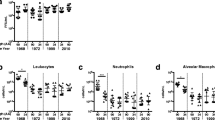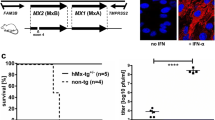Abstract
The highly pathogenic avian influenza virus H5N1 is known to induce high level of tumor necrosis factor α (TNF-α) from primary macrophages. However, it is still unclear whether current H5N1 strains also induce high TNF-α production, as most of the data were derived from extinct clade 0 H5N1 strain. Here, we show that current clade 1 and 2 H5N1 strains induce variable levels of TNF-α that are not necessarily higher than those induced by seasonal influenza viruses. The result suggests that hyper-induction of TNF-α in human macrophages is not always associated with a highly pathogenic phenotype. We further tested the contribution of the NS gene segment from H5N1 isolates to TNF-α induction by using reverse genetics. While NS conferred some variation in TNF-α induction when incorporated into an H1N1 virus genetic background, it did not affect TNF-α induction in an H5N1 virus genetic background, suggesting that other viral genes are involved.



Similar content being viewed by others
References
Abdel-Ghafar AN, Chotpitayasunondh T, Gao Z, Hayden FG, Nguyen DH, de Jong MD, Naghdaliyev A, Peiris JS, Shindo N, Soeroso S, Uyeki TM (2008) Update on avian influenza A (H5N1) virus infection in humans. N Engl J Med 358:261–273
Chan MC, Cheung CY, Chui WH, Tsao SW, Nicholls JM, Chan YO, Chan RW, Long HT, Poon LL, Guan Y, Peiris JS (2005) Proinflammatory cytokine responses induced by influenza A (H5N1) viruses in primary human alveolar and bronchial epithelial cells. Respir Res 6:135
Cheung CY, Poon LL, Lau AS, Luk W, Lau YL, Shortridge KF, Gordon S, Guan Y, Peiris JS (2002) Induction of proinflammatory cytokines in human macrophages by influenza A (H5N1) viruses: a mechanism for the unusual severity of human disease? Lancet 360:1831–1837
Claas EC, Osterhaus AD, van Beek R, De Jong JC, Rimmelzwaan GF, Senne DA, Krauss S, Shortridge KF, Webster RG (1998) Human influenza A H5N1 virus related to a highly pathogenic avian influenza virus. Lancet 351:472–477
de Jong MD, Simmons CP, Thanh TT, Hien VM, Smith GJ, Chau TN, Hoang DM, Chau NV, Khanh TH, Dong VC, Qui PT, Cam BV, Ha do Q, Guan Y, Peiris JS, Chinh NT, Hien TT, Farrar J (2006) Fatal outcome of human influenza A (H5N1) is associated with high viral load and hypercytokinemia. Nat Med 12:1203–1207
Gu J, Xie Z, Gao Z, Liu J, Korteweg C, Ye J, Lau LT, Lu J, Gao Z, Zhang B, McNutt MA, Lu M, Anderson VM, Gong E, Yu AC, Lipkin WI (2007) H5N1 infection of the respiratory tract and beyond: a molecular pathology study. Lancet 370:1137–1145
Guan Y, Peiris JS, Poon LL, Dyrting KC, Ellis TM, Sims L, Webster RG, Shortridge KF (2003) Reassortants of H5N1 influenza viruses recently isolated from aquatic poultry in Hong Kong SAR. Avian Dis 47:911–913
Guan Y, Poon LL, Cheung CY, Ellis TM, Lim W, Lipatov AS, Chan KH, Sturm-Ramirez KM, Cheung CL, Leung YH, Yuen KY, Webster RG, Peiris JS (2004) H5N1 influenza: a protean pandemic threat. Proc Natl Acad Sci USA 101:8156–8161
Hatta M, Gao P, Halfmann P, Kawaoka Y (2001) Molecular basis for high virulence of Hong Kong H5N1 influenza A viruses. Science 293:1840–1842
Korteweg C, Gu J (2008) Pathology, molecular biology, and pathogenesis of avian influenza A (H5N1) infection in humans. Am J Pathol 172:1155–1170
Li KS, Guan Y, Wang J, Smith GJ, Xu KM, Duan L, Rahardjo AP, Puthavathana P, Buranathai C, Nguyen TD, Estoepangestie AT, Chaisingh A, Auewarakul P, Long HT, Hanh NT, Webby RJ, Poon LL, Chen H, Shortridge KF, Yuen KY, Webster RG, Peiris JS (2004) Genesis of a highly pathogenic and potentially pandemic H5N1 influenza virus in eastern Asia. Nature 430:209–213
Neumann G, Watanabe T, Ito H, Watanabe S, Goto H, Gao P, Hughes M, Perez DR, Donis R, Hoffmann E, Hobom G, Kawaoka Y (1999) Generation of influenza A viruses entirely from cloned cDNAs. Proc Natl Acad Sci USA 96:9345–9350
Peiris JS, Yu WC, Leung CW, Cheung CY, Ng WF, Nicholls JM, Ng TK, Chan KH, Lai ST, Lim WL, Yuen KY, Guan Y (2004) Re-emergence of fatal human influenza A subtype H5N1 disease. Lancet 363:617–619
Perkins LE, Swayne DE (2001) Pathobiology of A/chicken/Hong Kong/220/97 (H5N1) avian influenza virus in seven gallinaceous species. Vet Pathol 38:149–164
Perrone LA, Plowden JK, Garcia-Sastre A, Katz JM, Tumpey TM (2008) H5N1 and 1918 pandemic influenza virus infection results in early and excessive infiltration of macrophages and neutrophils in the lungs of mice. PLoS Pathog 4:e1000115
Reed LJ, Muench H (1932) A simple method for estimating 50% endpoints. Am J Hyg 27:493–497
Subbarao K, Klimov A, Katz J, Regnery H, Lim W, Hall H, Perdue M, Swayne D, Bender C, Huang J, Hemphill M, Rowe T, Shaw M, Xu X, Fukuda K, Cox N (1998) Characterization of an avian influenza A (H5N1) virus isolated from a child with a fatal respiratory illness. Science 279:393–396
Acknowledgments
This project was supported by a research grant from the Thailand Research Fund (BRG5180008). The Mahidol University–University of Tokyo collaboration was supported by the JSPS (Japan Society for the Promotion of Science). Sirawat Srichatraphimuk and Yuwarat Monteerarat were supported by the Mahidol Medical Scholar Program. Pilaipan Puthavathana was supported by a Senior Research Scholar grant from the Thailand Research Fund. This work was also supported by National Institute of Allergy and Infectious Diseases Public Health Service research grants, by an NIAID-funded Center for Research on Influenza Pathogenesis (CRIP, HHSN266200700010C), by a Grant-in-Aid for Specially Promoted Research, by a contract research fund for the Program of Founding Research Centers for Emerging and Reemerging Infectious Diseases from the Ministry of Education, Culture, Sports, Science, and Technology, by grants-in-aid from the Ministry of Health and by ERATO (Japan Science and Technology Agency). H5N1 viral isolates from Thailand were kindly provided through collaboration with the Department of Medical Sciences, Bureau of Epidemiology and Faculty of Veterinary Science of Mahidol University, partly under a US CDC-funded collaborative project “Avian Influenza Surveillance in Thailand-Studies at Human–Animal Interface”. The viral strain collection was facilitated by the Thailand Avian Influenza Monitoring Network (TAIM Net) established by the National Center for Genetic Engineering and Biotechnology.
Author information
Authors and Affiliations
Corresponding author
Rights and permissions
About this article
Cite this article
Monteerarat, Y., Sakabe, S., Ngamurulert, S. et al. Induction of TNF-α in human macrophages by avian and human influenza viruses. Arch Virol 155, 1273–1279 (2010). https://doi.org/10.1007/s00705-010-0716-y
Received:
Accepted:
Published:
Issue Date:
DOI: https://doi.org/10.1007/s00705-010-0716-y




